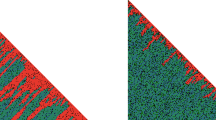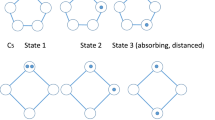Abstract
In this paper we consider a finite one-dimensional lattice with \(N = 2n + 1\) sites such that one of them is empty and the others have a black or white token. There are two players (one for each color), such that step by step alternately they move one of their tokens to the empty site trying to obtain a connected configuration. This game is related with the Schelling’s social segregation model, where colors represent two different populations such that each one tries to take up a position with more neighbors as itself (same color). In this work we study strategies to play the game as well as their relation with the associated Schelling’s one-dimensional case (line and cycle graphs).







Similar content being viewed by others
References
Berlekamp ER, Conway JH, Guy RK (1982) The winning games for your mathematical plays. Academic Press, Cambridge
Castellano C, Fortunato S, Loreto V (2009) Statistical physics for social dynamics. Rev Mod Phys 81:591
Clark WAV, Fossett M (2008) Understanding the social context of the Schelling segregation model. PNAS 105:4109–4114
Epstein JM, Axtell RL (1996) Growing artificial societies: social science from the bottom up. MIT Press, Cambridge
Goles N, Goles E, Rica S (2011) Dynamics and complexity of the Schelling segregation model. Phys Rev E 83:1–13
Hatna E, Berenson J (2012) The Schelling model of ethnic residential dynamics beyond the integrated-segregated dichotomy of patterns. J Artif Soc Soc Simul 15:6
Hegselmann R, Flache A (1998) Understanding complex social dynamics: a plea for cellular automata based modelling. J Artif Soc Soc Simul 1(3). http://jasss.soc.surrey.ac.uk/1/3/1/1.pdf
Pancs R, Vriend NJ (2007) spatial proximity model of segregation revisited. J Public Econ 91:1–24
Sandholm WH (2010) Population games and evolutionary dynamics. MIT Press, Cambridge
Schelling TC (1969) Models of segregation. Am Econ Rev 59:488–493
Schelling TC (1971) Dynamics of segregation. J Math Sociol 1:1–143
Schelling TC (2006) Micromotives and macrobehavior. Norton, New York
Vinkovic D, Kirman A (2006) A physical analogue of the Schelling model. PNAS 103:19261–19265
Acknowledgements
Acknowledgment to the Fondecyt Grant 1140090 (EG), MillenniumNS130017 (EG) and to the CMM-Basal (EG and LG).
Author information
Authors and Affiliations
Corresponding author
Rights and permissions
About this article
Cite this article
Goles, E., Gómez, L. Combinatorial game associated to the one dimensional Schelling’s model of social segregation. Nat Comput 17, 427–436 (2018). https://doi.org/10.1007/s11047-017-9622-5
Published:
Issue Date:
DOI: https://doi.org/10.1007/s11047-017-9622-5




